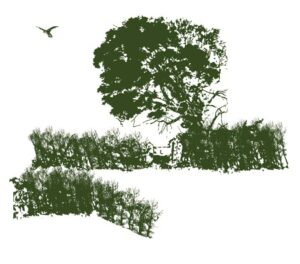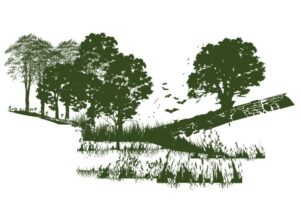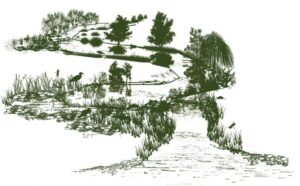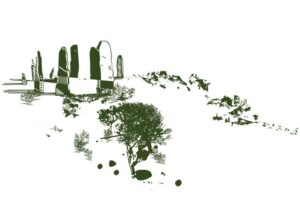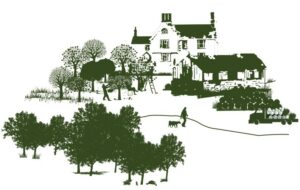Following these principles will help your scheme to achieve multiple benefits for the wider environment, ecology, heritage, visual landscape, and people whilst being fit for purpose in meeting your objectives. It will also help to minimise the risk of unintended consequences of planting the wrong tree in the wrong place.
-
Take account of the landscape context
- Ask ‘how could more tree cover and woodland in this landscape help maintain or enhance the character of the landscape and the way it functions?’
We believe all landscapes in Devon have some potential for increased woodland cover – some more than others depending on their key characteristics and special qualities. - Start by understanding the landscape. Survey the land – stand on a high point where you can gain a prospect over the area. Gain a deeper understanding of your local landscape and how its character is perceived by people – refer to Landscape Character Assessments. For proposals affecting National Parks and AONBs, ensure the natural beauty and special qualities of protected landscapes are conserved and enhanced. These are described in their Management /Partnership Plans. You can find links to the website of each protected landscape in Devon on the National and UNESCO designations page on Devon County Council’s Environment website.
- Seek inspiration – look at our annotated sketches showing Devon’s landscape now and our vision for how it could look in 30 years time with more tree cover. Read Landscape Character Assessments and associated guidelines applicable to the area; these suggest how you can respect and enhance the key characteristics and special qualities of your local landscape and protect and manage valued features which already provide environmental benefits. They also suggest ways you can positively change the landscape to deliver more environmental benefits, for example by linking existing fragmented woodland for the expansion of wildlife habitats.
- Once you’ve identified potential sites or features you want to change, undertake analysis – identify environmental sensitivities.
- Start to formulate your design proposals. Apply the UKFS design principles (see Step 4: Choose the right place) when siting and designing new woodland within the context of your local landscape area.
- Be aware of how insensitive woodland creation could harm or erode the special qualities and key characteristics of the landscape for future generations. Key challenges include fitting larger-scale woodland into existing historic field patterns and conserving views.
- If selecting non-native tree species that may be more climate resilient, consider the landscape context and how well they will fit into this once fully grown. Some species may ‘stick out like a sore thumb’ and should be used with care in the countryside, whilst others are visually very similar to our native trees.
- Whilst diversifying a woodland will make it more robust and resilient to a changing climate it must be done thoughtfully. For more on this issue see Woodland Trust’s Position Statement also the Forestry Commission’s Position Statement and their guidance on forest management in a Changing Climate
- Seek to retain contrasts between upland and lowland landscapes by respecting existing variations in hedge patterns, tree and hedge species, etc.
- Skylines in some Devon landscapes are particularly distinctive and may include landmarks and features that add to a sense of place. Care is needed to ensure new woodland creation maintains and respects such valued skylines.
- Landscapes that have not previously been enclosed, such as upland moorland and coasts, may have a high aesthetic, recreational and heritage value. These areas are frequently ‘Open Access’ land and are likely to be popular for recreation as they offer high scenic quality, a sense of vast scale, wildness, lack of human intervention and far-reaching views. Some scrub and woodland regeneration may be appropriate in upland river valleys of moorland areas, and at the margins of moorland and woodland, as it would allow natural transitions of habitats as part of a mosaic subject to dynamic change. This may be more appropriate to the natural character of such open unenclosed landscapes rather than creating blocks of distinct tree planting with hard linear edges.
- Respect local variations in tree species; for example Devon Whitebeam, Plymouth Pear and North Devon Mazzard (cherry). Hedge fruit trees are more common in West Devon, reflecting the fruit growing which historically took place here. Beech is characteristic in hedges on Exmoor and in the northern Blackdown Hills.
- Continue local landscape details, such as traditional local variations in hedge construction. Try to match the construction of nearby hedges.
- Ask ‘how could more tree cover and woodland in this landscape help maintain or enhance the character of the landscape and the way it functions?’
-
Work with nature
- Protect ecologically valuable non-wooded habitats such as flower rich grasslands, heathland, wetlands. These are known as ‘Priority Habitats’ (See our information in Step 3 on potential sensitivities). National Priority Habitats sourced from the Government’s MAGIC website can be seen on the woodland planting considerations map on DCC’s Environment Viewer. Some other important habitats may not be mapped, for example tussocky grassland that supports insects and small mammals and provides important feeding areas for bats and birds. If you are unsure about the habitat value of a site, seek specialist advice.
- Use the principle of ‘bigger, better, more joined up’. Take opportunities to link woodlands, copses, and hedges to create habitat corridors.
- Acknowledge the value of ‘edge’ and dynamic habitats – scrub areas on the edges of woodland which can be very rich in wildlife.
- If planting a woodland for biodiversity is the main aim, then select ecologically appropriate species for your scheme – i.e. look at the native species which are thriving nearby – and select a diversity of species. Consider the National Vegetation Classification (NVC) type associated with the soil and climate.
- Support some natural regeneration of woodland where this meets management objectives. This may help create more natural looking woodland, but depending on the availability of seed sources, it can fail to result in tree cover or lead to a monoculture.
- Help avoid the spread of disease by choosing trees that are certified ‘Plant Healthy’ and have been sourced and grown in the UK from nurseries with good biosecurity (see Step 7: Put your scheme into practice).
- Change management regimes of existing hedges to be more useful, abundant with wildlife, resilient, and better for carbon storage. Manage hedges using traditional techniques such as laying and coppicing, and allow some hedgerow trees to grow out. This will increase the hedges’ biodiversity value, as well as keeping them functional and providing shade for animals. Grassy hedge and field margins are also very important habitats and should be considered to be part of the hedge. Think of the long-term management of the hedge. See management advice published by Devon Hedge Group.
-
Address climate change and flooding
- Work with natural processes – take opportunities to ensure the creation of new woodland and hedges contributes to natural flood management within a river catchment.
Use the Environment Agency’s Resilient Catchment Management Tool to identify priority areas where hedge planting (along contours), catchment woodlands, riparian tree planting and valley floor woodland can help reduce surface water runoff and soil erosion. See also Devon County Council’s Natural Flood Management Guidance - Retain and enhance existing valley floor wetlands as habitats and flood storage.
- Chose a diversity of species to plant, to reduce the proportion potentially affected by new plant pests or diseases.
- Conserve soil quality and infiltration rates by ensuring tree establishment methods and management operations do not lead to soil compaction or pollution. Relieve areas of compacted soil prior to planting e.g. through ripping with a subsoiler. Avoid using heavy machinery where soils are wet.
- Plan for sustainable timber production in line with the UK Forestry Standard. We currently import 80% of our timber needs. Reducing this will not only help the economy but also reduce carbon emissions from fuel transporting this heavy product from overseas.
- Work with natural processes – take opportunities to ensure the creation of new woodland and hedges contributes to natural flood management within a river catchment.
-
Respect the past
- Respect the historic environment by re-establishing lost tree features in the landscape (for example orchards and woodlands) and strengthening historic field patterns where possible. (See Step 4: Choose the right place for more information).
- Avoid woodland planting in areas of rare historic field patterns (e.g. medieval strip fields and other intact medieval field systems). Instead, consider strengthening the field patterns through replacing lost sections of hedge, or managing existing hedges better for wildlife, to be more productive, and to store more carbon. (See Step 4: Choose the right place for more information).
- Designated heritage assets (Scheduled Monuments, Registered Parks and Gardens and Listed Buildings) are generally not appropriate areas for woodland planting.
- The settings of designated heritage assets should also be considered. Seek advice from a historic environment specialist if you are unsure about the potential impacts of your scheme on the setting of a designated asset.
- Not all historic or archaeological sites are designated, and some (such as earthworks and cropmarks) are highly sensitive to tree planting or scrub regeneration. Refer to the Historic Environment Record and woodland planting considerations map published on Devon County Council’s Environment viewer. Also, see Step 3: Check for potential sensitives for more information.
- Bear in mind that the growth of tree roots can damage below-ground archaeology. However, it is possible that land management practices in the past – such as repeated ploughing of fields – may already have caused damage. If in doubt, seek advice from a historic environment specialist.
- Work with landowners and Natural England to develop parkland management plans to promote the parkland and veteran trees of the future, and to encourage wood pasture.
- Respect the historic environment by re-establishing lost tree features in the landscape (for example orchards and woodlands) and strengthening historic field patterns where possible. (See Step 4: Choose the right place for more information).
-
Think about people and their opportunities to visit, work, and enjoy the landscape
- Identify opportunities to enable people to access trees and countryside through integrating things like new paths, Green Infrastructure and accessibility improvements into the planting design.
- Where appropriate, identify opportunities for tree planting to promote productive, economically profitable, and sustainable use of land.
- Where possible, integrate opportunities for new jobs, skills training, and participation of community volunteers for example with tree planting, woodland, and hedge management.
- Enable people to continue to enjoy wide open spaces and panoramic views from open access land, and ensure woodland design and future management allows people to enjoy publicly accessible viewpoints and vistas across a landscape without them becoming obscured by tree growth.
Step 3: Check for potential sensitivities
Step 1: Identify your objectives – Devon Local Nature Partnership (devonlnp.org.uk)
